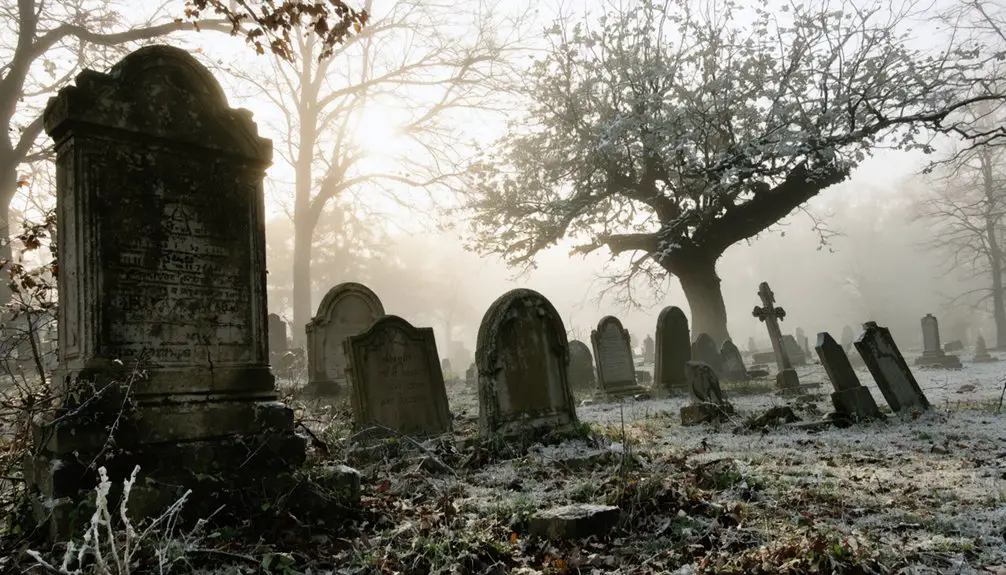You’ll discover Buck’s haunting remains in Vermont’s Green Mountains, where Colonel Jonathan Buck’s 1762 settlement once flourished with sawmills and growing families. Today, abandoned foundations and a mysterious granite monument mark this ghost town’s location, with its infamous witch’s curse still visible as an unexplainable foot-shaped stain. The rugged mountain terrain and dense forests now guard countless supernatural tales, historical landmarks, and Buck’s Revolutionary War legacy.
Key Takeaways
- Buck, founded by Colonel Jonathan Buck in 1762, transformed from a thriving settlement into a ghost town following economic decline.
- The town’s economy centered around marble quarries, but their closure led to mass exodus and deterioration of local infrastructure.
- The Buck Family Memorial, featuring a mysteriously stained granite monument, serves as the ghost town’s primary historical landmark.
- Local supernatural legends include the witch’s curse, unexplained phenomena, and reported sightings of strange lights and ghostly figures.
- Multiple hiking trails connect abandoned foundations and historical sites, requiring proper etiquette to preserve the area’s historical integrity.
The Legacy of Jonathan Buck: A War Hero’s Settlement

While many early American settlements faded into obscurity, the legacy of Colonel Jonathan Buck lives on through the town he founded in coastal Maine.
You’ll find Buck’s leadership woven into the very fabric of what became Bucksport, where he established the region’s first sawmill, gristmill, and boat.
Born in 1719 in Woburn, Massachusetts, he ventured to the Penobscot River’s mouth in 1762 to survey and develop new township lands. By 1775, his determined leadership had grown the settlement to twenty-one families.
A determined pioneer from colonial Massachusetts, Buck journeyed north to Maine’s wilderness, seeking opportunity along the Penobscot’s shores.
Despite wartime hardships that forced him to flee 200 miles to Massachusetts during the Revolutionary War, Buck’s determination never wavered. Along with his fellow commanders, he suffered through one of the most humiliating defeats in American naval history.
After returning in 1783, he led the settlement’s rebuilding efforts, transforming it into a strategic hub.
His contributions to settlement development earned him such respect that in 1817, the town was officially renamed Bucksport in his honor.
The Witch’s Curse and the Mysterious Footprint
Beyond Jonathan Buck’s achievements as a pioneer and leader, a darker tale haunts his legacy in Bucksport, Maine. The witch legend emerged in late 19th-century newspapers, describing how Buck ordered the execution of a woman accused of witchcraft. With her dying breath, she cursed him, vowing her foot would forever mark his grave.
Years after Buck’s descendants erected his monument in 1852, a mysterious stain appeared on the granite, eerily resembling a human foot. Despite numerous cleaning attempts, the mark persists.
The cursed monument draws curious visitors seeking supernatural mysteries, though its location is often mistakenly attributed to Vermont. While some versions claim the accused was Buck’s mistress or an indigenous woman, the core story remains: a haunting reminder of colonial-era injustice and supernatural retribution. Colonel Buck died in 1795, decades before the monument’s construction. Experts have concluded that the mark is simply a natural iron vein in the stone, debunking supernatural claims.
From Thriving Community to Abandoned Town
As Vermont’s marble industry boomed in the 19th century, Buck emerged as a thriving community centered around its productive quarries.
You’d find a bustling town with country stores, specialty shops, and a mix of agriculture and logging operations supporting the local economy. Like the historic White River Valley, Buck relied heavily on logging activities to sustain its economic growth.
The signs of economic decline became apparent as the quarries slowed:
- Young residents left for urban opportunities, leading to demographic shifts
- Local businesses dependent on quarry workers began closing their doors
- Infrastructure and housing fell into disrepair as tax revenues dropped
Despite attempts at community resilience, Buck couldn’t overcome the challenges of industrial collapse. In 1968, author Pearl Buck attempted to revitalize the area by establishing Vermont Village Square, but her efforts ultimately proved insufficient.
Local Legends and Supernatural Tales
Despite Buck’s physical abandonment, supernatural legends persist in this quiet Vermont ghost town, particularly drawing inspiration from the famous witch’s curse story of Bucksport, Maine.
You’ll find tales that echo Colonel Jonathan Buck’s haunted monument, where an unexplainable foot-shaped stain defies removal – a symbol of an alleged witch’s dying curse.
Like many New England communities, Buck’s supernatural sightings interweave with the region’s dark history of tuberculosis hauntings and mysterious disappearances. Townspeople claim to witness figures that resemble the frozen buried elders who allegedly came back to life in springtime.
Much like the Bennington Triangle region, locals report strange lights and UFO sightings in the surrounding wilderness.
Local folklore tells of eerie experiences similar to those reported in Bennington County, where unexplained phenomena and vanishings have occurred in the mountain wilderness.
Mysterious vanishings and unexplained events in Buck mirror those of Bennington’s mountain wilderness, where hikers still disappear without trace.
These stories connect Buck to a broader tapestry of New England’s ghostly heritage, where abandoned towns often become focal points for otherworldly tales.
The Rugged Mountain Landscape
You’ll find Buck Mountain’s challenging terrain defined by steep, forested slopes ranging from 899 to 1,332 feet in elevation, with dense northern hardwoods giving way to spruce-fir forests near the summit.
The mountain’s rugged landscape, shaped by ancient glacial activity, features rocky outcrops and narrow, unmarked paths that wind through the thick vegetation. The summit elevation of 406 meters offers an impressive vantage point for visitors exploring the area. To ensure authentic access to the mountain trails, visitors must complete a verification process at designated ranger stations.
Hidden access points dot the mountainside, though many have become obscured over time by the encroaching forest and the mountain’s naturally difficult topography.
Steep Forest-Covered Peaks
Nestled in the western reaches of Vermont’s Green Mountains, Buck Mountain rises to a modest elevation of 899-940 feet while maintaining surprisingly steep terrain.
You’ll find its steep slopes densely covered with diverse forest ecosystems, featuring a rich mix of northern hardwoods and conifers that create a rugged, untamed landscape.
The mountain’s dramatic topography offers:
- Sharp inclines and rocky outcrops that challenge even experienced hikers
- Dense forest biodiversity with maple, beech, and birch trees dominating the canopy
- Natural valleys carved by nearby rivers, enhancing the peak’s wild character
Despite ranking #2,008 in Vermont’s elevation list, Buck Mountain’s steep forest-covered peaks contribute to the region’s watershed protection and provide essential wildlife habitat within the broader Green Mountain range.
Hidden Mountain Access Points
While Buck Mountain’s rugged terrain presents a challenge to visitors, several hidden and unmarked trailheads provide access to its slopes.
You’ll find informal routes branching from small parking areas and campgrounds, often a half-mile from official entry points. These hidden trailheads typically require traversing dirt roads and seasonal paths, demanding vehicles suited for rough terrain.
The routes weave through dense forest and rocky outcrops, with some paths leading past Deer Leap’s cliffs – home to diving Peregrine Falcons.
You’ll need to rely on GPS direction or local knowledge, as many trails lack formal markers. Mountain streams and secluded ponds dot these informal routes, offering natural rest stops.
Remember that conditions can change drastically with seasons, transforming familiar paths into challenging scrambles across exposed rock faces.
Natural Terrain Challenges
Rising 2,600 feet above Vermont’s valley floor, White Rocks dominates the landscape with its formidable quartzite cliffs and treacherous terrain.
You’ll encounter natural hazards at every turn as you navigate this unforgiving wilderness, where house-sized boulders from massive rockslides litter the slopes.
Terrain navigation proves especially challenging due to:
- Dense northern hardwood forests with thick undergrowth that severely limits visibility
- Unstable ground conditions from abandoned mine shafts and hidden sinkholes
- Slick quartzite surfaces that remain dangerously wet in shaded areas
The mountain’s microclimate adds another layer of complexity, with temperatures dropping 15-20 degrees in shadowed valleys and caves.
Ice beds persist in protected caverns, while thick canopy coverage creates darkness so complete you can’t see through the forest.
Historical Landmarks and Modern Tourism
You’ll find the Buck Family Memorial as the centerpiece of this ghost town, featuring the granite monument erected in 1852 that’s famous for its mysterious leg-shaped stain linked to a witch’s curse.
Today’s visitors can explore multiple hiking trails that wind through the abandoned town, connecting various historical landmarks including the remnants of Buck’s original sawmill and grist mill.
The memorial site and surrounding trails offer an immersive look into Vermont’s early industrial history, while attracting tourists interested in both the paranormal legend and the region’s cultural heritage.
Buck Family Memorial Site
The Buck Family Memorial Site stands as a tribute to Jonathan Buck’s legacy, featuring two distinct markers: the original modest slate gravestone from 1795 and a 15-foot blue granite monument erected by his great-grandchildren in 1852.
The memorial significance extends beyond simple remembrance, marking the transformation from Plantation No. 1 to modern-day Bucksport.
You’ll discover these intriguing elements at the site:
- A mysterious leg-shaped stain on the granite that refuses to fade, spawning local witch curse legends
- Historical documentation of Buck’s Revolutionary War service and town founding accomplishments
- Preserved genealogical records that showcase the family’s continued influence in the region
Today, the memorial serves as a focal point for heritage tourism, drawing visitors interested in both early American history and supernatural folklore.
Ghost Town Hiking Trails
While the Buck Family Memorial Site preserves the town’s founding legacy, Buck’s surrounding wilderness beckons modern adventurers through an extensive network of ghost town hiking trails.
You’ll discover abandoned foundations, broken headstones, and historical fire pits as you traverse the mountainous terrain.
For hiking safety, you’ll need to prepare for variable weather conditions and challenging landscapes ranging from gentle climbs to steep gullies.
Remember proper trail etiquette: respect private property boundaries, park only in designated areas, and avoid disturbing historical artifacts.
The trails reward you with scenic summit viewpoints and pristine wilderness solitude, especially along Long Trail sections.
Watch for interpretive signs that highlight the region’s logging heritage and settlement history while you explore these remote pathways through Vermont’s forgotten past.
Frequently Asked Questions
Are There Any Surviving Descendants of Jonathan Buck Living in Vermont Today?
You’ll find Buck descendants in Vermont today, particularly John Buck and his family in Washington, Vermont, who run Buck Family Maple Farm, though complete Vermont genealogy records aren’t publicly documented.
What Was the Accused Witch’s Name and Personal Background Before the Trial?
While widows faced persecution, Margarete Schumacher, later Widow Krieger, lived as a prosperous mill owner’s wife in Massachusetts before moving to Vermont, where she’d face a witch trial in 1785.
Was Buck’s Town Connected by Railroad to Other Vermont Settlements?
You’ll find no clear evidence of railroad connections between Buck and other settlements, though nearby logging railroads in South Glastenbury suggest possible indirect access during the region’s settlement expansion period.
Did Any Notable Criminals or Fugitives Hide in Buck’s Abandoned Buildings?
Picture empty, weathered buildings standing silent – you won’t find any evidence of criminal hideouts or notorious fugitives in Buck’s abandoned structures. Historical records don’t support claims of outlaws sheltering there.
What Native American Tribes Originally Inhabited the Buck Settlement Area?
You’ll find the Western Abenaki heritage deeply rooted in this land, as their tribal history shows they inhabited Vermont’s region for thousands of years before European contact, including Buck’s territory.
References
- https://enchantednewengland.com/stories-all/johnathan-buck-monument-cursed-by-witch
- https://www.vermonter.com/ricker-basin-vermont-ghost-town/
- https://www.youtube.com/watch?v=6zrC4j7tGHE
- https://obscurevermont.com/curious-wallingford/
- https://montpelierbridge.org/2022/10/ghost-towns-of-new-england/
- https://www.tumbleweedstripod.com/post/the-curse-of-jonathan-buck
- https://www.thedistractedwanderer.com/2013/07/the-buck-may-not-stop-at-jonathan-buck.html
- https://thomology.com/getperson.php?personID=I2458&tree=Thompson
- https://www.seekingmyroots.com/members/files/G000707.pdf
- https://www.newenglandinnsandresorts.com/inspiration/the-blog/6-chilling-new-england-ghost-stories



